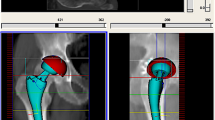Summary
Follow-up examinations of 67 implants of cement-free ceramic sockets show the need for an exact definition of failure, to warrant comparable evaluations of results. Statistical survival analysis offers the possibility of presenting both the incidence of failures and the dates of their occurrence. If only revision surgery with removal of the socket is considered to be a failure, our material shows the “survival quota” of the ceramic socket after 8 years to be 96.7% ± 2.2%. If radiological signs of loosening are included in the evaluation of failures, the “survival quota” of the stable implants is reduced to 81.9% ±6.9%.
Zusammenfassung
Anhand der Nachuntersuchung von 67 zementfrei implantierten keramischen Füßchenpfannen wird die Notwendigkeit der genauen Definition des Fehlschlages aufgezeigt, um dadurch eine vergleichbare Beurteilung der Ergebnisse zu gewährleisten. Die statistische Methode der Überlebenszeitanalyse bietet die Möglichkeit, sowohl die Häufigkeit der Fehlschläge als such den Zeitpunkt ihres Auftretens darzustellen. Wird ausschließlich die Reoperation mit Austausch der Pfanne als Fehlschlag bewertet, so ergibt sich im eigenen Material nach 8 Jahren eine „Überlebensquote” der keramischen Pfanne von 96,7% ± 2,2. Werden zusätzlich radiologische Lockerungszeichen in die Fehlschlagbeurteilung aufgenommen, so reduziert sich die „Überlebensquote” der stabilen Implantate auf 81,9% ± 6,9.
Similar content being viewed by others
References
Boutin P (1977) L'arthroplastic totale de la hanche par prothèse en alumine — results de 150 cas d'ancrage direct de la pièce acétabulaire. Int Orthop 1:87–94
Buchholz HW, Heinert K, Wargenau M (1985) Verlaufsbeobachtung von Hüftendoprothesen nach Abschluß realer Belastungsbedingungen von 10 Jahren. Z Orthop 123:815–820
Dawihl W, Mittelmeier H, Doerre E, Altmeyer G, Hanser U (1979) Zur Tribologie von Hüftgelenk-Endoprothesen aus Aluminiumoxidkeramik. MOT 99:114–118
Dorey F, Amstutz HC (1986) Survivorship analysis in the evaluation of joint replacement. J Arthroplasty 1:63–69
Griss P (1983) Ergebnisse der teilweise zementfrei implantierten Keramik-Keramik-Hüftendoprothesen Typ Lindenhof 4–8 Jahre postoperativ. In: Morscher E (ed) Die zementlose Fixation von Hüftendoprothesen. Springer, Berlin Heidelberg New York, pp 226–230
Griss P, Hackenbroch M, Jäger M, Preussner B, Schäfer T, Seebauer R, van Eimeren W, Winkler W (1982) Findings on total hip replacements for ten years. Aktuel Probl Chir Orthop 21
Knahr K, Salzer M, Plenk H Jr, Grundschober F, Ramach W (1981) Experience with bioceramic implants in orthopaedic surgery. J Biomaterials 2:98–104
Mittelmeier H (1983) Keramikhüftgelenkprothesen mit zementfreier Verankerung. In: Morscher E (ed) Die zementlose Fixation von Huftendoprothesen. Springer, Berlin Heidelberg New York, pp 231–249
Morscher E, Schmassmann A (1983) Failures of total hip arthroplasty and probable incidence of revision surgery in the future. Arch Orthop Trauma Surg 101:137–143
Rose RM, Radin EL (1982) Wear of polyethylene in the total hip prosthesis. Clin Orthop 170:107–115
Salzer M, Zweymüller K, Locke H, Plenk H, Punzet G (1975) Erste Erfahrungen mit einer Hüfttotalendoprothese aus Biokeramik. Med Orthop Technik 95:162–164
Salzer M, Zweymüller K, Locke H, Zeibig A, Stark N, Plenk H, Punzet G (1976) Further experimental and clinical experience with aluminium oxide endoprostheses. J Biomed Mater Res 10:847–856
Salzer M, Knahr K, Plenk H Jr (1981) Long-term clinical and histological evaluation of bioceramic total hip endoprostheses. Orthopaedics 4/11:1231–1240
Semlitsch M, Lehmann M, Doerre E, Willert HG (1976) Neue Perspektiven zu verlängerter Funktionsdauer künstlicher Hüftgelenke durch Werkstoffkombination Polyäthylen-Aluminiumoxidkeramik-Metall. MOT 96:152–160
Willert HG, Semlitsch M, Buchhorn G, Kriete U (1978) Materialverschleüß und Gewebereaktion bei künstlichen Gelenken. Orthopäde 7:62–83
Author information
Authors and Affiliations
Rights and permissions
About this article
Cite this article
Knahr, K., Böhler, M., Frank, P. et al. Survival analysis of an uncemented ceramic acetabular component in total hip replacement. Arch. Orth. Traum. Surg. 106, 297–300 (1987). https://doi.org/10.1007/BF00454337
Received:
Issue Date:
DOI: https://doi.org/10.1007/BF00454337




